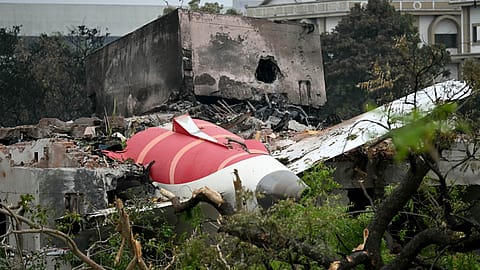Air India flight 171 suffered dual engine shutdown after take-off from Ahmedabad: AAIB report
The engine fuel cutoff switches were recorded transitioning from 'RUN' to 'CUTOFF' positions in rapid succession—just one second apart, says the AAIB report.

Air India flight AI171, which crashed in Ahmedabad on June 12, experienced a dual engine shutdown seconds after take-off, according to a preliminary report released by Aircraft Accident Investigation Bureau (AAIB) on the fatal crash involving Air India’s Boeing 787-8 Dreamliner.
The aircraft, registered VT-ANB, had earlier arrived from Delhi as flight AI423 and landed in Ahmedabad. During post-flight checks, the crew reported a “STAB POS XDCR” message (stabilizer sensor defect) in the technical log. Following this, Air India’s engineering team conducted troubleshooting and cleared the aircraft for its next flight.
At 13:18 IST, the aircraft pushed back from Bay 34 and began taxiing for departure. Take-off clearance was granted at 13:37 IST and the aircraft began its roll on Runway 23. According to flight data, the aircraft reached its rotation speed of 155 knots at 13:38:35 IST and lifted off seconds later.
However, just moments after take-off, at 13:38:42 IST, both engines abruptly shut down. The engine fuel cut-off switches were recorded transitioning from 'RUN' to 'CUTOFF' positions in rapid succession—just one second apart, the 15-page report noted. Cockpit voice recordings captured one pilot asking, “Why did you cut off?” to which the other pilot responded, “I did not,” the report said.
The aircraft’s Ram Air Turbine (RAT), a backup power source that deploys during electrical emergencies, was observed deploying immediately after lift-off, according to the CCTV footage obtained from the airport by AAIB.
No significant bird activity is observed in the vicinity of the flight path, the report by the aircraft accident investigation bureau said. The aircraft started to lose altitude before crossing the airport perimeter wall. With both engines shutting down and losing power, the aircraft began descending.
As per the Enhanced Airborne Flight Recorder data, the Engine 1 fuel cutoff switch transitioned from 'CUTOFF' to 'RUN'. Thereafter, the Engine 2 fuel cutoff switch also transitions from 'CUTOFF' to 'RUN'. "When fuel control switches are moved from CUTOFF to RUN while the aircraft is inflight, each engines full authority dual engine control (FADEC) automatically manages a relight and thrust recovery sequence of ignition and fuel introduction," the report said.
Recommended Stories
While Engine 1’s core deceleration stopped, reversed and started to progress to recovery, Engine 2 was able to relight but could not arrest core speed deceleration and re-introduced fuel repeatedly to increase core speed acceleration and recovery, the report noted.
One of the pilots transmitted “MAYDAY MAYDAY MAYDAY”. The air traffic control at Ahmedabad enquired about the call sign. The ATC did not get any response but observed the aircraft crashing outside the airport boundary.
Air India on Saturday issued a formal response following the release of the preliminary investigation report by the Aircraft Accident Investigation Bureau (AAIB) into the fatal crash of flight AI171. The airline reiterated its support for those affected, saying, “Air India stands in solidarity with the families and those affected by the AI171 accident.”
The crash, which occurred on June 12 near Ahmedabad, claimed 260 lives — including 241 passengers and crew on board and 19 people on the ground. The 15-page preliminary report released by the AAIB on July 12 outlines early findings into the causes and technical circumstances surrounding the accident.
(INR CR)
In a statement issued on Saturday, Air India said, “We continue to mourn the loss and are fully committed to providing support during this difficult time.” The airline confirmed that it has received the AAIB’s report and is actively engaging with the authorities: “Air India is working closely with stakeholders, including regulators. We continue to fully cooperate with the AAIB and other authorities as their investigation progresses.”
While the preliminary report includes initial observations, the airline declined to comment on the findings, citing the ongoing nature of the investigation. “Given the active nature of the investigation, we are unable to comment on specific details and refer all such enquiries to the AAIB,” the statement added.
The AAIB is expected to release a final report after completing a detailed technical analysis and gathering additional evidence.